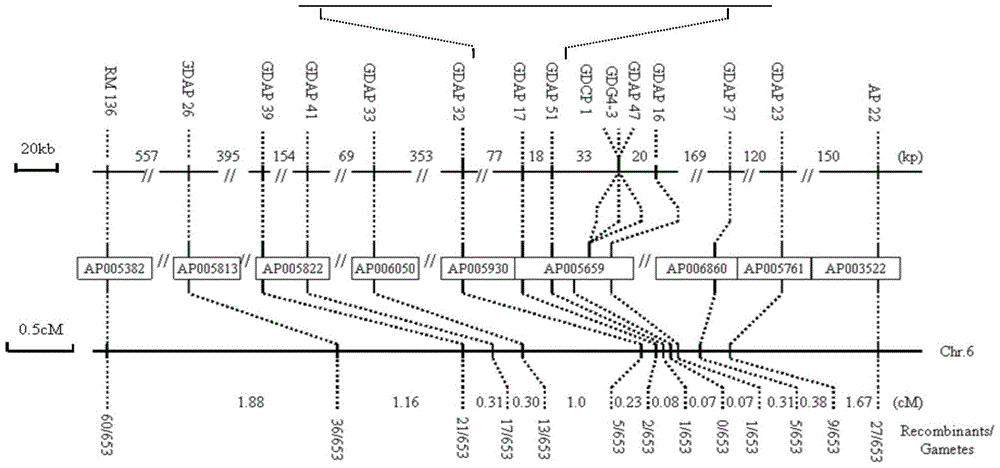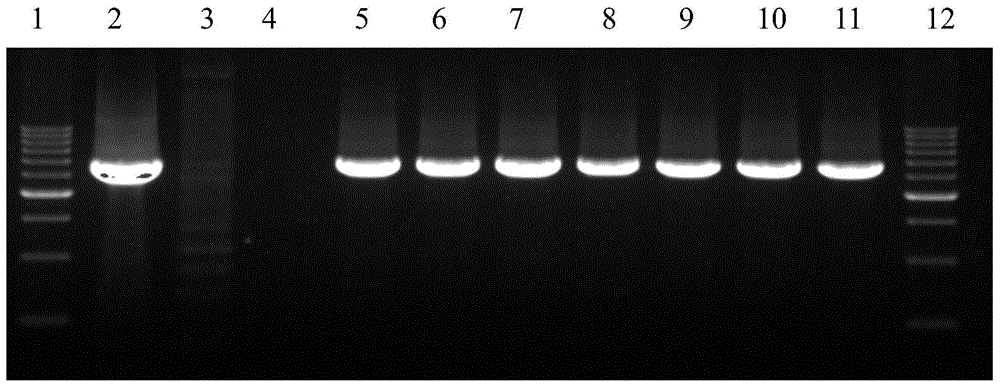Rice blast resistance gene pi50 and its preparation method and application
A technology of resistance gene and rice blast, which is applied in the fields of botanical equipment and methods, biochemical equipment and methods, and application, etc., can solve problems such as short-lived resistance, and achieve the effect of shortening breeding time.
- Summary
- Abstract
- Description
- Claims
- Application Information
AI Technical Summary
Problems solved by technology
Method used
Image
Examples
Embodiment 1
[0027] Example 1 Analysis and Determination of Rice Blast Resistance Gene Pi50
[0028] 1. Annotation and sequence analysis of rice blast resistance gene Pi50 candidate gene
[0029] In order to determine the candidate gene of Pi50, the inventors of the present invention used the reference sequence of Nipponbare, through two kinds of gene prediction software RiceGAAS (http: / / ricegaas.dna.affrc.go.jp) and Softberry's FGENESH (http: / / www. softberry.com) performed gene prediction and annotation analysis on the target gene region. In Nipponbare, the candidate resistance genes in the Pi50 region are candidate genes of seven nucleotide binding sites and leucine-rich repeat (NBS-LRR) (Pi501-NP, Pi502- NP, Pi503-NP, Pi504-NP, Pi505-NP, Pi506-NP and Pi507-NP), among which Pi501-NP and Pi507-NP are highly conserved among the varieties held by the reported Pi2 / 9 family, with little difference. Based on the completeness of genes and the presence / absence (presence / absence, P / A) of specif...
Embodiment 2
[0039] Example 2: Genetic complementation experiment of rice blast resistance gene Pi50 and identification of transformants
[0040] 1. Obtaining the Pi50-N4 gene
[0041] Using the EBZ genome as a template, the Pi50-N4 genome gene was amplified by the following primers:
[0042] Upstream primer F2: 5'- ACGAATTCGAGCTCGGTACC CTTGACATCCAAACCGCACC-3';
[0043] Downstream primer R2: 5'- AGTGCCAAGCTTCGGCGCGCC TCAGCCAGCTTGAGCTGTGC-3'.
[0044] The PCR reaction system is: high-fidelity enzyme KOD plus neo 0.4μl, EBZ genome template 1.2μl (100pg~50ng), DMSO 0.5μl, primer F2 (10μM) 0.6μl, primer R2 (10μM) 0.6μl, dNTP (2mM) 4μl , 10 μl of 2-fold concentration buffer solution (2×buffer), and 20 μl of double distilled water.
[0045] The PCR temperature cycle conditions are: 94°C for 2 minutes; 98°C for 10 seconds, 56°C for 30 seconds, 68°C for 9 minutes, and the extension time at 68°C runs 5 cycles with a gradient of 10 seconds in each cycle; 98°C for 10 seconds, 68°C for 10 min...
PUM
 Login to View More
Login to View More Abstract
Description
Claims
Application Information
 Login to View More
Login to View More - R&D
- Intellectual Property
- Life Sciences
- Materials
- Tech Scout
- Unparalleled Data Quality
- Higher Quality Content
- 60% Fewer Hallucinations
Browse by: Latest US Patents, China's latest patents, Technical Efficacy Thesaurus, Application Domain, Technology Topic, Popular Technical Reports.
© 2025 PatSnap. All rights reserved.Legal|Privacy policy|Modern Slavery Act Transparency Statement|Sitemap|About US| Contact US: help@patsnap.com



